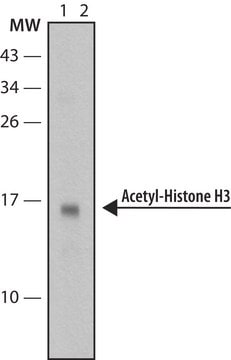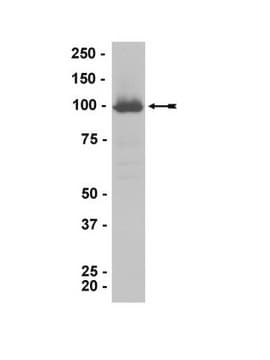07-355
Anti-acetyl-Histone H3 (Lys23) Antibody
serum, Upstate®
Synonim(y):
H3K23Ac, Histone H3 (acetyl K23)
About This Item
Polecane produkty
pochodzenie biologiczne
rabbit
Poziom jakości
forma przeciwciała
serum
rodzaj przeciwciała
primary antibodies
klon
polyclonal
reaktywność gatunkowa
Saccharomyces cerevisiae, human, vertebrates
producent / nazwa handlowa
Upstate®
metody
ChIP: suitable
dot blot: suitable
western blot: suitable
numer dostępu NCBI
numer dostępu UniProt
Warunki transportu
wet ice
docelowa modyfikacja potranslacyjna
acetylation (Lys23)
informacje o genach
human ... H3C1(8350)
Opis ogólny
The N-terminal tail of histone H3 protrudes from the globular nucleosome core and can undergo several different types of epigenetic modifications that influence cellular processes. These modifications include the covalent attachment of methyl or acetyl groups to lysine and arginine amino acids and the phosphorylation of serine or threonine.
Specyficzność
Immunogen
Zastosowanie
Representative lot data.
Sonicated chromatin prepared from HeLa cells (1 X 10E6 cell equivalents per IP) were subjected to chromatin immunoprecipitation using 2 µL of either normal rabbit serum or 2 µL Anti-acetyl-Histone H3 (Lys23)and the Magna ChIP A Kit (Cat. # 17-610). Successful immunoprecipitation of acetyl-Histone H3 (Lys23) associated DNA fragments were verified by qPCR using Control Primers specific for the human GAPDH promoter region as a positive locus, and MyoD primers as a negative locus. Data is presented as percent input of each IP sample relative to input chromatin for each amplicon and ChIP sample as indicated.
Please refer to the EZ-Magna ChIP A (Cat. # 17-408) or EZ-ChIP (Cat. # 17-371) protocol for experimental details.
Western Blot Analysis:
Representative lot data.
Acid extracts from sodium butyrate treated HeLa cells (Lane 1, Catalog # 17-305) and recombinant Histone H3 (Lane 2, Catalog # 14-494) were probed with Anti-acetyl-Histone H3 (Lys23) (1:100,000 dilution).
Arrow indicates acetyl histone H3 (~17 kDa)
Dot Blot:
Representative lot data.
40 ng and 4ng amounts of histone peptides with various modifications (see table 1) were transferred to PVDF membrane and probed with Anti-Acetyl-Histone H3 (Lys23) antibody (1:2000 dilution). Proteins were visualized using a goat anti-rabbit IgG conjugated to HRP and a chemiluminescence detection system. Image from a 60 second exposure is shown.
Epigenetics & Nuclear Function
Histones
Jakość
Opis wartości docelowych
Postać fizyczna
Przechowywanie i stabilność
Komentarz do analizy
Acid extracts from sodium butyrate treated HeLa cells
Informacje prawne
Oświadczenie o zrzeczeniu się odpowiedzialności
Not finding the right product?
Try our Narzędzie selektora produktów.
Kod klasy składowania
10 - Combustible liquids
Klasa zagrożenia wodnego (WGK)
WGK 1
Certyfikaty analizy (CoA)
Poszukaj Certyfikaty analizy (CoA), wpisując numer partii/serii produktów. Numery serii i partii można znaleźć na etykiecie produktu po słowach „seria” lub „partia”.
Masz już ten produkt?
Dokumenty związane z niedawno zakupionymi produktami zostały zamieszczone w Bibliotece dokumentów.
Nasz zespół naukowców ma doświadczenie we wszystkich obszarach badań, w tym w naukach przyrodniczych, materiałoznawstwie, syntezie chemicznej, chromatografii, analityce i wielu innych dziedzinach.
Skontaktuj się z zespołem ds. pomocy technicznej








